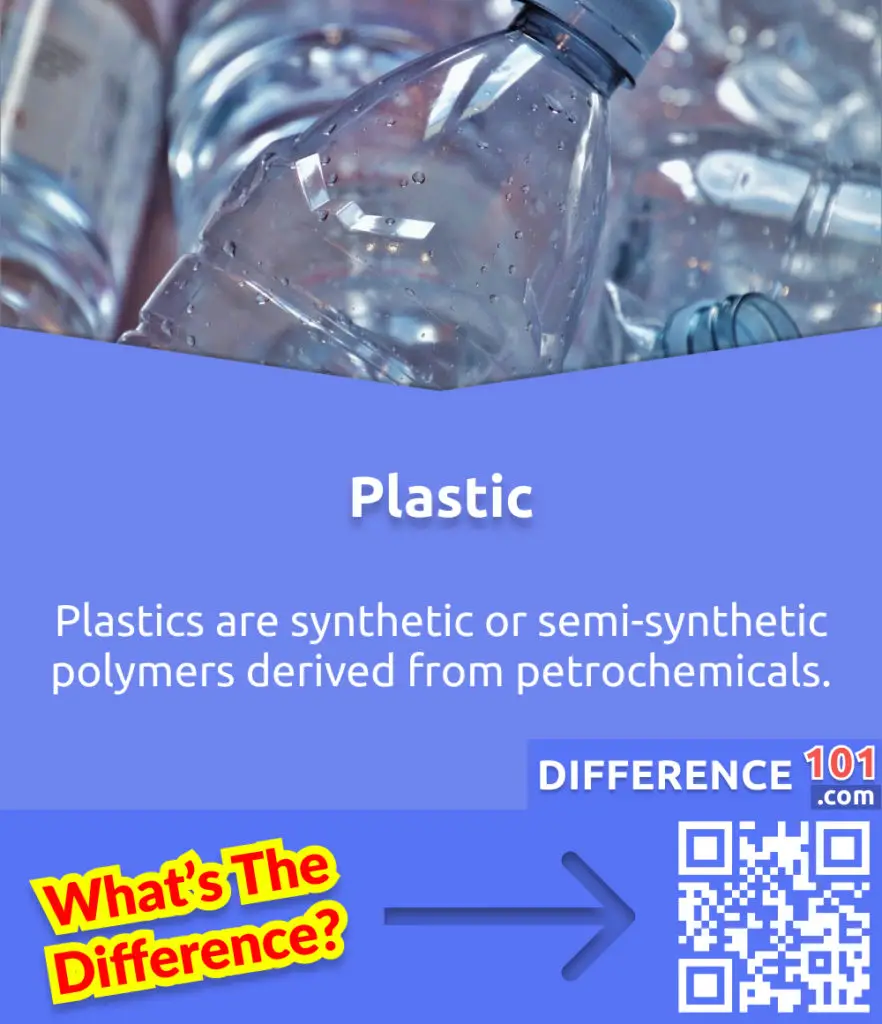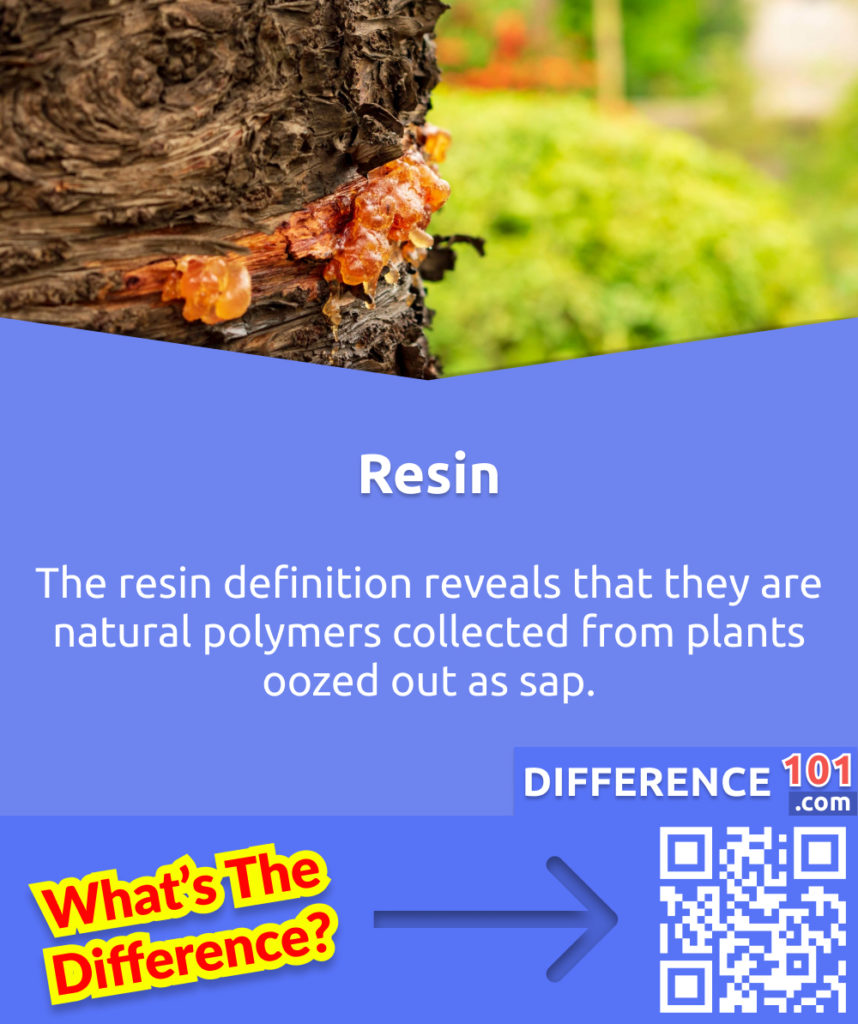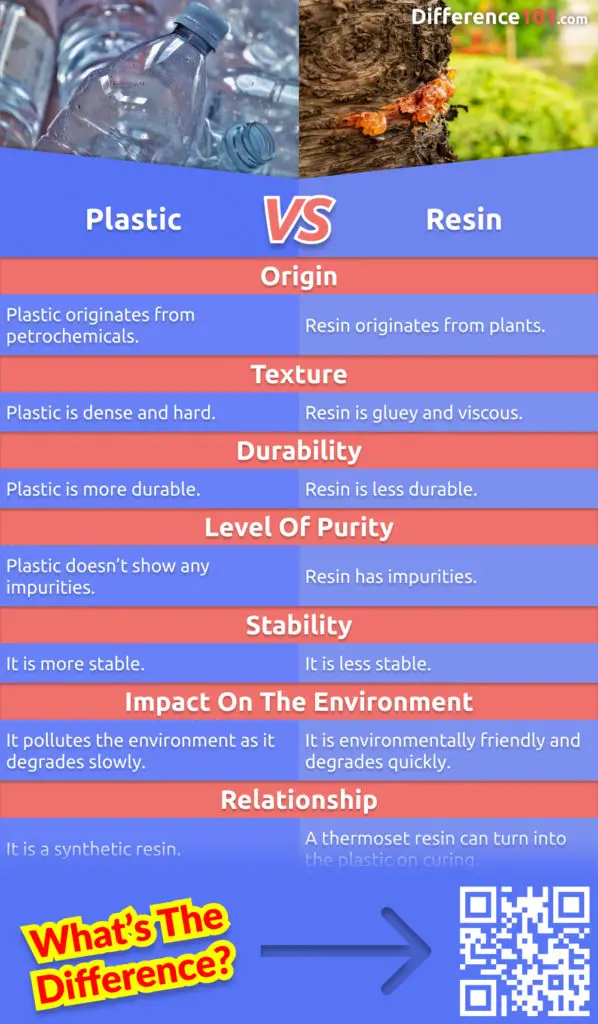Both resin and plastic are polymers. The biggest plastic vs. resin difference lies in their origin. Resins mostly have a natural origin since they are obtained from plants. Plastics, on the other hand, are obtained from petrochemicals and have a synthetic polymeric nature. Plastics can be called a type of synthetic resin.
Let’s take a closer look at resin vs. plastic:
| Polymers | Both resin and plastic are polymers |
| Natural | Resin is natural while plastic is not |
| Durability | Plastic is more durable than resin |
| Impurities | The resin contains impurities while plastic does not |
Table des matières
What is Plastic?
Plastics are synthetic or semi-synthetic polymers derived from petrochemicals.

What is Resin?
The resin definition reveals that they are natural polymers collected from plants oozed out as sap.

Plastic vs. Resin Pros and Cons
Plastic Pros and Cons
Pros of Plastic
- Plastic is durable and lasts longer than resin.
- Plastic is an affordable material.
- Plastic is resistant to heat.
- Plastic doesn’t have impurities.
Cons of Plastic
- Molding or reshaping plastic often leads to faulty results and thus, need redos.
- Modifying plastic products is expensive when carried on a smaller scale.
- Plastic does not hold the colors painted on it well.
- Synthetic plastics cause environmental pollution as they are harder to break down.

Resin Pros and Cons
Pros of Resins
- Resin is ideal for casting larger designs.
- Resin can hold intricate details in terms of design and shapes.
- It is a great material for small and medium-sized businesses or artisans as it can be worked on well in small batches.
- Resin is environment-friendly.
Cons of Resins
- Resin bubbles a lot that impacts the aesthetics of the product.
- Resin is toxic to work with for longer periods and with greater proximity.
- Products made from resin are less durable.
- Resin has impurities.

Plastic and Resin Examples
Examples of Plastic
- Polyethylene Terephthalate, commonly known as PET
- Polyvinyl Chloride or PVC
- Polypropylene (PP)
- Low-Density Polyethylene (LDPE)
- Polystyrene (PS)
Examples of Resin
- Amber
- Balsam
- Boswellia
- Copal
- Balm of Gilead (Ref.1)
Understanding the Similarities Between Plastic and Resin
- Both consist of long chains of hydrocarbons and are thus polymers.
- Both are lightweight materials.
- Both plastic and resin can be a bit difficult to recycle if processed synthetically.
7 Key Points of Difference Between Plastic and Resin That You Need to Know
| Basis | Plastic | Resin |
|---|---|---|
| Origin | Plastic originates from petrochemicals. | Resin originates from plants. |
| Texture | Plastic is dense and hard. | Resin is gluey and viscous. |
| Durability | Plastic is more durable. | Resin is less durable. |
| Level of purity | Plastic doesn’t show any impurities. | Resin has impurities. |
| Stability | It is more stable. | It is less stable. |
| Impact on the environment | It pollutes the environment as it degrades slowly. | It is environmentally friendly and degrades quickly. |
| Relationship | It is a synthetic resin. | A thermoset resin can turn into the plastic on curing. |
Comparison Chart

Comparison Video
Plastic and Resin FAQs
What is the Strongest Glue for Plastic?
Cyanoacrylate aka super glue is one of the strongest glues for plastic. They can be used on all types of plastics and are extremely easy to use. They might require a primer to prepare smooth plastics. You can also consider using epoxy resin for plastic repair.
Is Resin Eco-friendly?
The resin definition reveals that these are derived from natural sources and are, therefore, eco-friendly. Eco-resin, epoxy resin, and silicone resin are all biodegradable. On the other hand, resin plastic is made from synthetic fibers and is not eco-friendly. Polyester resin, thermoset resin, and polyurethane resin are all non-biodegradable.
What is Polyresin?
Considering polyresin vs. resin, poly resins are synthetic resins with excellent strength. They are high-density polymers that are water-resistant and transparent. These are made from polyhydric alcohols and dibasic organic acids. (Ref. 2) Since they are produced from fossil sources, they can neither be recycled nor be decomposed.
What are the Two Types of Resin?
Resins can be broadly classified into natural and synthetic depending on their source.
Does Resin Break Easily?
The natural resin might break depending on its thickness and curation. Synthetic resin, on the other hand, does not break easily. When choosing between resin vs. plastic models, amateur miniature artists might not choose resin because of its brittle nature. Considering acrylic resin vs. epoxy resin, epoxy resin is stronger than acrylic resin.
How Durable is Plastic?
For its long-chain carbon bonds, plastic takes many hundreds, if not thousands, years to decompose (Ref. 3). Also, when exposed to UV light, it takes only 20 years for these to decompose. Considering plastic vs. nylon, the latter is much more durable than plastic.
What is the Best Material for Adirondack Chairs?
Famed as the most comfortable chair for the outdoors, Adirondack chairs were originally made from teak wood. Since teak is water, wind, and rust-resistant, and excretes oil that guards against scratching and denting, it has been the best material for Adirondack chairs.
Does Resin Become Plastic?
Yes, when a thermoset resin is cured, it turns into plastic or rubber. This happens due to the extension of chain bonds that occurs while individual chains combine to form covalent bonds. (Ref. 4)
Is Resin Cheaper than Plastic?
No, the resin is costlier than plastic.
The Final Words
The resin and plastic difference mainly concerns the origin of these two polymers. Plastics are obtained from petrochemicals while the resin is derived from plants. So resins have a more natural origin than plastics. Since resins are derived directly from nature, it becomes impossible to avoid impurities. Plastics, on the other hand, lack impurities because they are usually semi-synthetic and synthetic. Plastics are more stable and durable than resins. Another major difference between plastics and resins lies in their capability to cause environmental pollution. Resins are environmentally friendly while plastics cause environmental pollution since they degrade very slowly.







